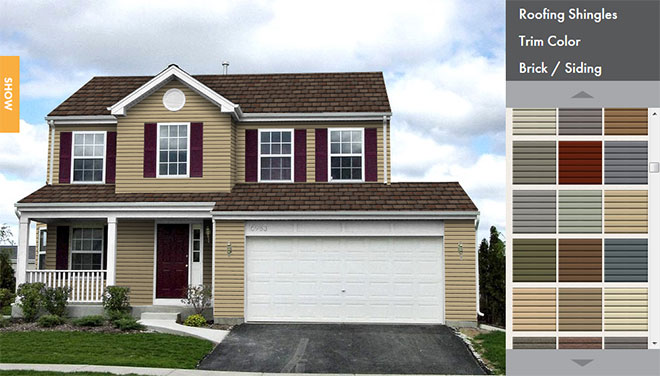St Louis Park Minnesota Homeowners Assessing Hail Damage
Several Minneapolis metro area communities were affected by hailstorms last night including: St. Louis Park, Golden Valley, Eden Prairie and Edina. This quick developing storm front deposited golf ball sized hail over downtown Minneapolis. The Minnesota Twins baseball game had to be postponed for 1 hour and 4 minutes. Hail this size causes damage to cars, windows, siding, roofing and gutters. Many Minneapolis metro area residents and property owners may have experienced significant damage as a result of this storm.
Hail Ratings & Your Roof | Are There Hail-Proof Roofs?
No roofing material is fully hail proof. If anyone saw or was involved in the hailstorms that went through Minnesota last night, you know what we’re talking about. There are hail-RESISTANT roofs. These products have Class 1 through Class 4 hail-resistance ratings, 4 being the highest. The ratings are given by taking a steel ball and dropping it from a pre-determined height and measuring the damage the roof has sustained. The American Society of Testing and Materials (ASTM) perform the tests.
Many roofs carry this rating. For steep slope, these roofs include some metal roofs, some tile and some composition shingles. For flat roofs, these are some gravel-surfaced built-up, and some spray foam (with the right coating system), and just a few others.
Installing a Class IV hail resistant roof may qualify you for lower insurance premiums, depending on where you live. Call your agent for verification. Keep this in mind, too, not many agents and adjusters will know the specifics about hail resistant roofs. Consult a good Minnesota hail damage repair roofing contractor.
Roof Hail Damage
It is often difficult to determine whether or not a shingle roof needs to be replaced after a hail storm because damage is not readily evident. There are a few ways to make this determination.
1. Look in your gutter or at the ground around your house. If you see a large amount of granules then reroofing would be a consideration. Granules are not just there for appearance purposes, they are there to protect the asphalt based roof product (the shingle). Asphalt and the sun don’t mix. The sun will beat it up pretty badly. It does not take much of a hail storm to dislodge a bunch of granules, thereby exposing the asphalt and shortening the service life of your roof. However, I must warn that telling one’s insurance company that roof damage is present, but the damage is not visible could easily turn into an unpleasant confrontation between a person and their insurance company. So here’s what you could do in that case…
2. If your roof went through a moderate hailstorm but no damage was readily visible, you should note the date and time of the storm, then notify your insurance company that you didn’t observe any damage on your roof, but that doesn’t mean it isn’t there. Then you should sit back and wait a few months. If enough granules were knocked loose, the sun will hit the exposed asphalt (even though you can’t readily see it, it is there). The exposed asphalt will deteriorate and more granules will come loose. In a few months and after a few rains, the damage will be readily evident. But before you go running to your insurance company, you will need to have done your due diligence.
o Take a lot of photos of the roof just after the storm (and after it’s dried if it’s wet). Make sure the date is shown on the photo.
o Also take photos of piles of hail and of the size of the hailstones next to a quarter, ruler, or something to reference the size of the hailstones.
o Then document every rain storm afterward (date and amount of rain) and take pictures of granules that have come off the roof.
If your roof looks much worse after about 4 to 6 months, take this information to your insurance agent and tell him you need a new roof.
3. Many times hailstorms produce visible damage, but the damage is fairly sporadic and sparse on the roof. What you can do in this case is quite simple. Take a 5 foot by 5 foot section of the roof, and mark it with something. I like blue, chalkline chalk, the kind available at any hardware store, because it washes off easily. Then take a photo of the section you use and use more chalk and mark each hail impact you find and take another photo. Do this in three areas. Then take the average number of hail impacts found, multiply that by 4, and get the average amount of hail impacts per square that your roof has experienced.
With this information, you can then call your insurance company and ask, “How many impacts per SQUARE constitute a new roof?” (One roof SQUARE equals 100 square feet. So when you hear a roofer talk about a roof that is 100 SQUARES in size, it is actually 100 times 100, or 10,000 square feet.)
Then you’ll know whether or not you should be getting a new roof. Just for the reader’s information, I’ve heard it’s between 5 and 10 damaging impacts per square, depending on which insurance company you talk to. The ideal thing to do would be to get this information BEFORE a hailstorm occurs, and file it away with your insurance papers. Again, do your due diligence by writing down the date and time you called, and who it was you spoke with, first and last name. Please note that it could several phone calls before a person finds the information they are looking for.
Remember, just because you do not see any damage to your roof, it doesn’t mean that your roof is not damaged. It just means you need to have a trained eye take a look for you.
Storm Damage Insurance Repair Contractor Minnesota
If your roof has been damaged by a storm whether by wind, hail or rain, trust your repairs to a Minnesota storm damage insurance repair contractor. They will be able to assist you assist you in filing an Insurance Claim including:
- Initiate claim
- Claim paper work
- Detailed estimate
- Meet with adjuster
- Negotiate the scope and cost of repairs with insurance company
- Arrange proper payment from insurance company to property owner
Don’t wait until it’s too late. You have two (2) years to file a claim for damage to your property. If your property is located in close proximity to the path of one of these storms you should have it inspected to ensure that you will not have a problem down the road.


 Click Here
Click Here Click Here To Use
Click Here To Use